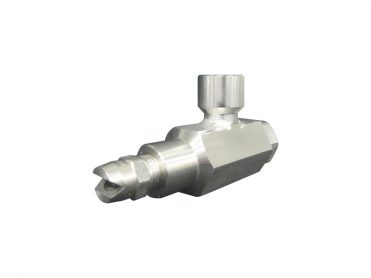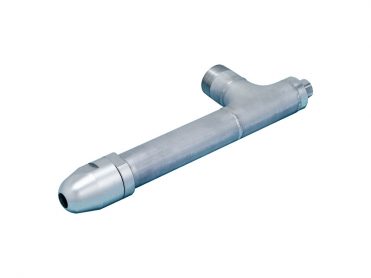Air Blower Pneumatic Nozzles
Our pneumatic nozzles are separated into three categories representing the way air is supplied to the nozzle before being mixed with a liquid:
- compressed air pneumatic nozzles;
- blower-air pneumatic nozzles;
- special pneumatic nozzles (like steam driven).
Air blower pneumatic nozzles are a part of the pneumatic nozzles category, which means they are two-fluids nozzles. They differentiate themselves from air nozzles with the addition of another fluid besides air. They also use a high-velocity flow of compressed air that gives them distinctive features, as opposed to hydraulic nozzles. Most of the time, the air is used to break down the water in tiny particles, even smaller than what hydraulic nozzles produce. They can spray very small droplets down to 7 μm, and they fit in situations where:
- fine atomization is required;
- a viscous liquid is sprayed;
- a large turn-down ratio is required;
- extremely small spray capacity is required.
Types of air driven pneumatic nozzles
In the current sub-category, we can encounter the following products:
- BAVV series
- LSIM series
Product description and characteristics
What is the concept behind the air blower pneumatic nozzles?
The air blower pneumatic nozzles or low-pressure nozzles use the outdoor air at normal pressure to be efficient. They are very cost-efficient and require little initial costs compared to compressed air nozzles. Depending on your application and industry, you might find the right nozzles among low-pressure nozzles.
What are their main features of air blower pneumatic nozzles?
The technology behind the air blower pneumatic nozzles allows the integration of two types of fluids within the spraying capabilities: air plus a fluid liquid. As these types of nozzles utilize the outdoor air and do not require a compresses system, the energy consumption for a product from this category is substantially lower.
The two nozzle products encountered in IKEUCHI’s catalog have differentiate themselves from one another as they are suitable for different types of applications. The first criteria of differentiation is the spray distribution. One of the nozzles offers an even distribution thanks to the full cone spray pattern, while the other has a mountain-shaped distribution due to its design and flat spray pattern. The spray capacity of the nozzle with an even distribution can spray between 0-1000 L/h, and it is optimal for a spraying angle of 20°. In the case of the mountain-shaped distribution nozzle, the spraying capacity is narrowed down between the interval 9.0 – 123 L/h, and as a result, the nozzle is optimal for a spray angle of 60°.
In order to achieve an accurate and optimum spray pattern, it is recommended to place both the air and liquid pressure at 0.02 MPa (ca. 0.2 bar). The air flows are dependent variable that rely on the selected pressure. That is why applying this type of pressure can lead to an air consumption of up 6,000 L/min for the even distribution nozzle. In the case of the mountain-shaped one, the air consumption will vary between 76 – 254 L/min.
Both nozzles present certain similarities to the hydraulic hollow cone nozzles, as they have a similar type of droplet sizes: fine and semi-fine. Moreover, the flat spray pattern nozzle has similar characteristics to the hydraulic solid stream nozzles, being engineered with a clog-resistant design.
At IKEUCHI, we have determined the fundamentals to select the right nozzle for your application based on their characteristics. When selecting the nozzle, we advise you based on your required spray angle, spray capacity, optimum spray pattern, and spray distribution.
If you have technical question about nozzles, need advice to select the proper solutions, or request a quote,


